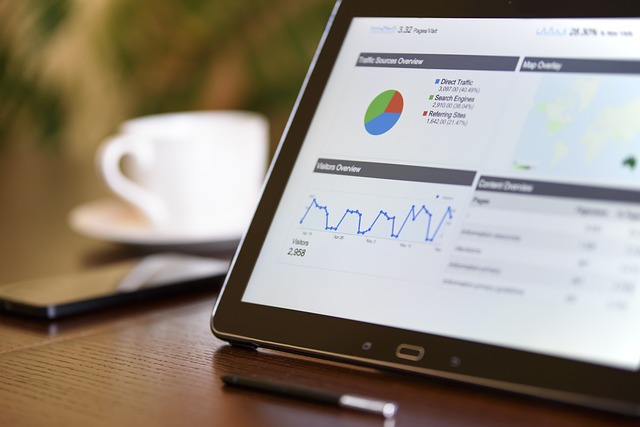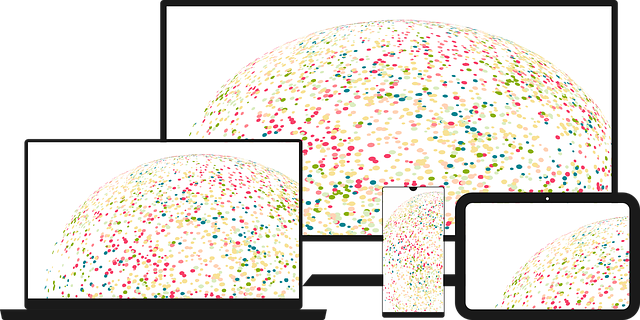In Digital Marketing, Conversion Rate Optimization (CRO) is a data-driven strategy that boosts website visitor actions like purchases or sign-ups by understanding user behavior through analytics and A/B testing. Key elements like CTAs, landing pages, and forms are optimized for a compelling experience tailored to customer needs. User Experience (UX) Design minimizes friction points, while A/B testing allows data-backed decisions on web page elements. Effective copywriting, visually appealing content, and strategic CTAs further enhance conversion rates. Personalization and segmentation target specific user groups for better engagement. AI and Predictive Analytics are transforming CRO with personalized, innovative marketing strategies.
Conversion Rate Optimization (CRO) is a pivotal strategy in digital marketing, focusing on enhancing website performance by maximizing the percentage of visitors who take a desired action. This article delves into the essence of CRO, guiding you through its various facets. From setting clear conversion goals and UX design principles to A/B testing, landing page optimization, and the power of copywriting, each section offers valuable insights. Additionally, we explore advanced techniques like AI and predictive analytics, highlighting future trends in digital marketing’s ever-evolving landscape.
Understanding Conversion Rate Optimization (CRO): The Digital Marketing Strategy

Conversion Rate Optimization (CRO) is a data-driven strategy within digital marketing that focuses on enhancing the percentage of website visitors who take a desired action, such as making a purchase or signing up for a newsletter. It involves understanding user behaviour through analytics and A/B testing to identify areas where improvements can be made. By optimizing key elements like call-to-actions (CTAs), landing pages, and forms, businesses can create more compelling experiences that align with customer needs and preferences.
In the dynamic landscape of digital marketing, CRO plays a pivotal role in maximizing the potential of website traffic. It’s not just about attracting visitors; it’s about converting them into customers or leads. By continuously testing and refining various aspects of a website, businesses can ensure their online presence is as effective as possible in achieving its marketing goals.
Defining Conversion Goals and Metrics for Your Website

Defining conversion goals is a crucial step in any Digital Marketing strategy. It involves identifying specific actions that you want visitors to take on your website, such as making a purchase, signing up for a newsletter, or downloading an e-book. These goals should be aligned with your overall business objectives and be measurable, so you can track progress and success. Conversion metrics are the tools that help you quantify these goals. Common metrics include conversion rate (the percentage of visitors who complete the desired action), cost per acquisition (the average amount spent to acquire a new customer), and return on investment (ROI). By setting clear, data-driven conversion goals and tracking relevant metrics, businesses can make informed decisions to optimize their websites for better performance in driving conversions.
When defining these goals and metrics, it’s essential to consider your target audience, the value proposition of your products or services, and the user experience on your website. Each of these elements plays a significant role in influencing customer behavior and conversion rates. For instance, a simple and intuitive checkout process can significantly improve e-commerce conversions by reducing friction for customers. Understanding your audience’s needs, preferences, and pain points is vital to creating compelling content and calls-to-action that resonate with them, thereby increasing the likelihood of conversions.
User Experience (UX) Design: Creating a Seamless Path to Conversion

In the realm of Digital Marketing, User Experience (UX) Design plays a pivotal role in Conversion Rate Optimization (CRO). A well-crafted UX ensures that every interaction between potential customers and your website is seamless and intuitive, guiding them naturally towards the desired action—be it making a purchase, signing up for a newsletter, or filling out a form. By understanding user behavior and pain points, designers can create flows that minimize friction, enhancing the overall customer journey.
This approach involves carefully mapping out each step of the conversion process, from initial site entry to final checkout or sign-up. Optimizing elements like navigation, call-to-actions (CTAs), form design, and page load speed contributes to a more engaging and efficient user experience. In turn, this increases the likelihood of conversions, as users are more likely to complete tasks when they encounter minimal obstacles and enjoy a streamlined digital interaction.
A/B Testing: Unlocking the Power of Experimentation

In the realm of digital marketing, A/B testing is a powerful tool that enables businesses to unlock the full potential of their online platforms. This experimental approach involves creating two versions of a webpage or element—Version A and Version B—and presenting them to different segments of visitors to gauge their responses. By comparing key performance indicators (KPIs) such as click-through rates, conversion rates, and time spent on page, marketers can make data-driven decisions that enhance user experience and drive better outcomes.
The beauty of A/B testing lies in its ability to cut through the noise and uncover nuanced preferences within your audience. Whether it’s tweaking headlines, modifying call-to-action buttons, or rearranging layout elements, each variation offers a chance to optimize and refine marketing strategies. This iterative process ensures that digital marketing campaigns remain dynamic and responsive, continually adapting to meet the evolving needs and behaviors of online users.
Optimizing Landing Pages for Higher Conversions

In the realm of Digital Marketing, Conversion Rate Optimization (CRO) is a powerful strategy to maximize the potential of your online efforts. One key area to focus on is optimizing landing pages, which serve as the gateway for prospective customers. By refining these pages, businesses can significantly improve their chances of converting visitors into paying customers or subscribers. A well-optimized landing page ensures that every element, from headlines to call-to-actions (CTAs), aligns with the marketing campaign’s goal.
To achieve this, marketers should keep the design clean and uncluttered, ensuring a seamless user experience. Incorporating compelling visuals, concise copy, and clear CTAs can capture attention and guide visitors towards desired actions. Additionally, A/B testing different versions of landing pages allows for data-driven decisions, identifying what resonates best with the target audience. This iterative process helps refine the page’s performance, ultimately increasing conversion rates in today’s competitive digital landscape.
The Role of Persuasive Copywriting in CRO

In the realm of Digital Marketing, Conversion Rate Optimization (CRO) is a powerful strategy to enhance online performance and drive business growth. Persuasive copywriting plays an indispensable role in this process. It’s not just about crafting appealing content; it involves understanding customer psychology to create compelling messages that nudge potential buyers towards desired actions. Skilled copywriters leverage the art of persuasion to craft compelling headlines, engaging product descriptions, and persuasive calls-to-action (CTAs), all designed to capture attention and foster a sense of urgency.
Through strategic word choices and storytelling techniques, persuasive copywriting influences buyer behavior. It converts casual visitors into engaged prospects by presenting benefits rather than just features. By focusing on how a product or service solves customer pain points, copywriters can create an emotional connection, encouraging conversions. In today’s competitive digital landscape, where consumers are bombarded with endless options, well-crafted copy can be the differentiator that drives sales and solidifies brand loyalty.
Leveraging Visual Elements and Call-to-Actions (CTAs) Effectively

In the realm of Digital Marketing, Conversion Rate Optimization (CRO) is a powerful tool to enhance user engagement and drive desired actions on websites or landing pages. Leveraging visual elements and strategically placing Call-to-Actions (CTAs) can significantly impact a website’s performance. Visually appealing graphics, high-quality images, and videos capture attention and convey messages more effectively than text alone. These elements create an emotional connection with the audience, making them more receptive to calls to action.
When incorporating CTAs, ensure they stand out against the page’s background and use clear, compelling language that encourages users to take the desired step. Placement is key; positioning CTAs above the fold or within easy scrolling distance improves their visibility and increases the likelihood of a user clicking. By combining powerful visuals with well-designed CTAs, marketers can create a seamless user experience that guides potential customers through the sales funnel, ultimately driving conversions in today’s competitive digital landscape.
Personalization and Segmentation for Targeted Conversion Campaigns

In the realm of Digital Marketing, personalization and segmentation are powerful tools for enhancing Conversion Rate Optimization (CRO) campaigns. By tailoring content and offers to specific customer segments, businesses can significantly improve engagement and conversion probabilities. Personalization involves creating customized experiences for individual users based on their unique preferences, behaviors, and demographics. This strategy leverages data-driven insights to deliver targeted messages that resonate with each segment, fostering a stronger connection between the brand and its audience.
Segmentation, on the other hand, divides customers into distinct groups based on shared characteristics, such as purchasing history, browsing behavior, or geographic location. This enables marketers to create highly relevant campaigns tailored to each segment’s specific needs and preferences. For instance, sending promotional emails featuring products a customer has previously shown interest in can significantly increase the chances of a purchase. Such targeted approaches not only elevate engagement rates but also contribute to more efficient marketing spend by ensuring that every communication aligns with the receiver’s interests.
Advanced Techniques: AI, Predictive Analytics, and Future Trends in CRO

In the realm of Digital Marketing, Conversion Rate Optimization (CRO) continues to evolve with advanced techniques leveraging Artificial Intelligence (AI) and Predictive Analytics. AI-driven tools can analyze vast amounts of data to understand user behavior patterns, enabling marketers to create hyper-personalized experiences tailored to individual preferences. This level of customization significantly improves engagement and boosts conversion rates.
Looking ahead, future trends in CRO are poised to be even more innovative. Advanced analytics will incorporate machine learning algorithms to forecast customer actions with unprecedented accuracy. Virtual reality (VR) and augmented reality (AR) technologies may also find their place in CRO, offering immersive experiences that can better capture and retain user attention. These developments promise to revolutionize digital marketing strategies, ensuring businesses stay ahead in a competitive online landscape.
